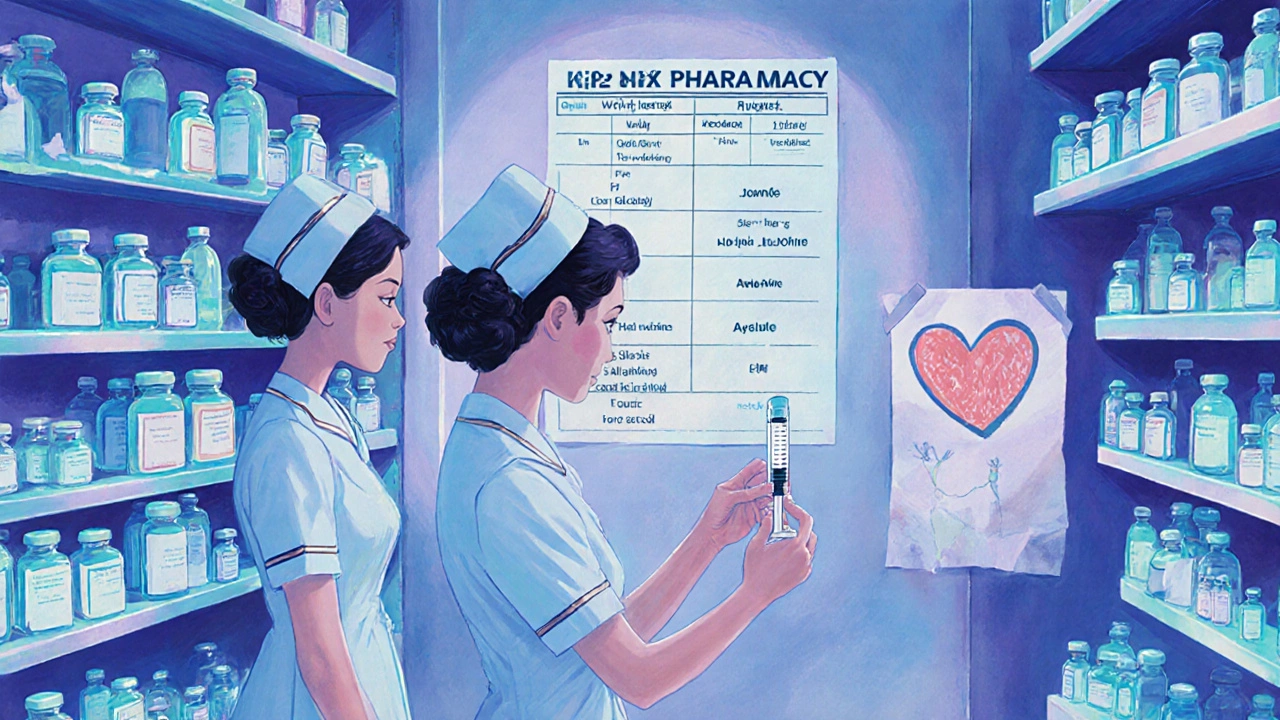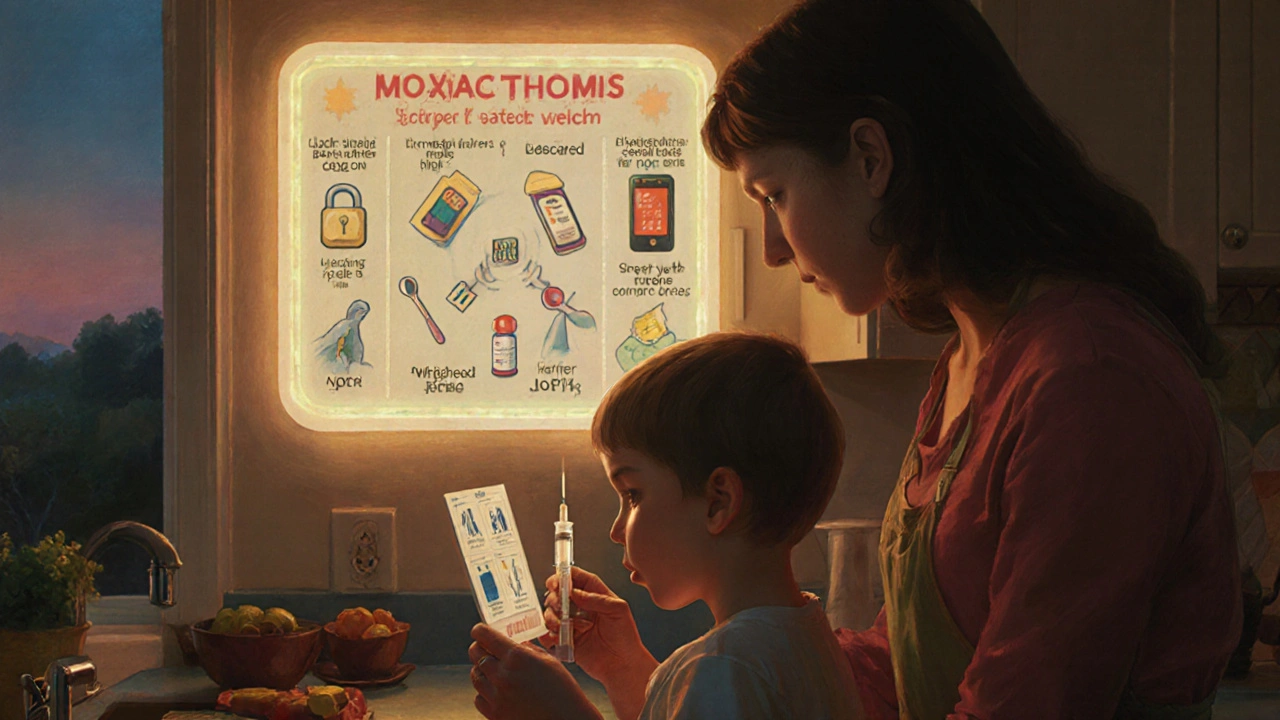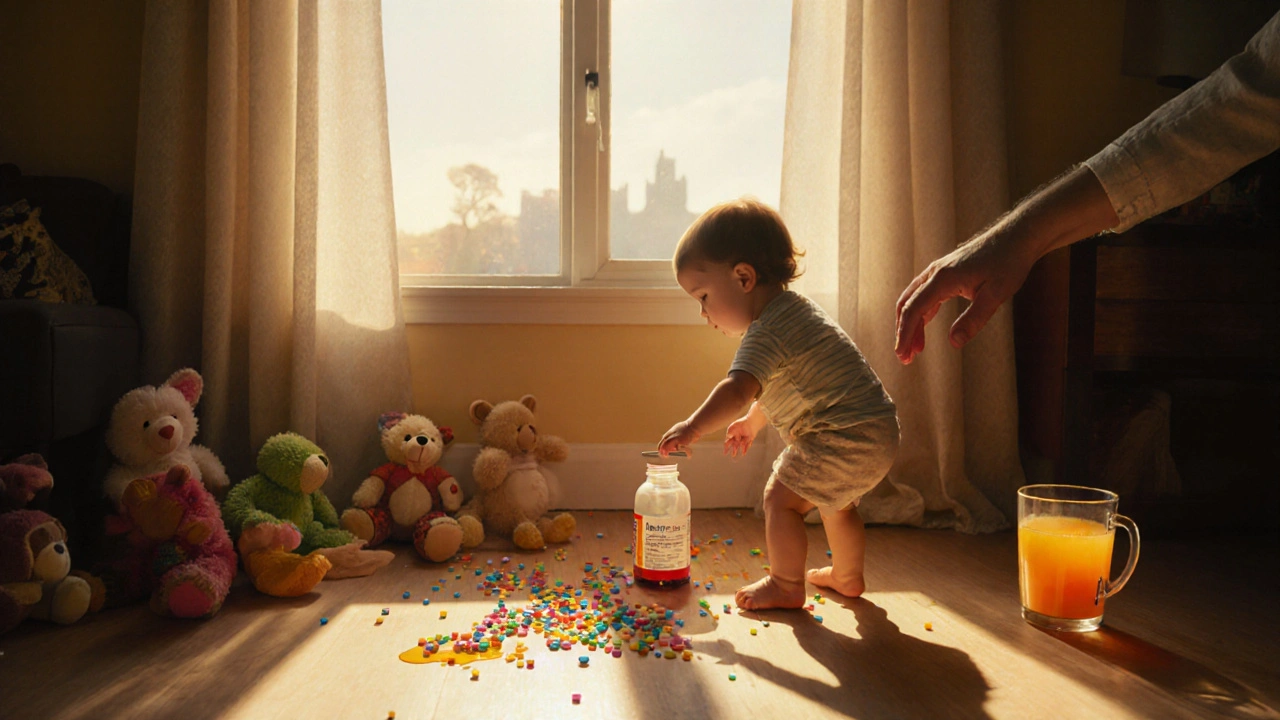Pediatric Medication Dosage Calculator
Calculate Safe Medication Dose
This calculator helps determine the correct dose for children based on their weight. Always consult your child's doctor before administering any medication.
Enter your child's information above to calculate the correct dose.
Recommended Dose
Use the dosing device provided with the medication. This calculator shows the dose in milliliters (mL) which is the correct unit for children's medications.
Every year, 50,000 children under age 5 end up in emergency rooms because they got into medicine they shouldn’t have. Many of these cases aren’t accidents-they’re preventable mistakes rooted in one simple truth: children are not small adults. Their bodies process drugs differently, they can’t tell you when something feels wrong, and even a tiny mistake in dosage can turn a life-saving pill into a life-threatening one.
Why Kids Are at Higher Risk
Children’s bodies are still growing. Their kidneys and liver, which break down and remove medications, aren’t fully developed until adolescence. A dose that’s perfect for a 70-kilogram adult might be ten times too much for a 7-kilogram infant. That’s not a guess-it’s science. The MedPak Pediatric Medication Safety Guide (2023) shows that kids face medication errors about three times more often than adults. And it’s not just about size. A child’s brain doesn’t yet understand that a colorful pill isn’t candy. That’s why telling a child, “This is medicine, but it tastes good,” is one of the most dangerous things a parent can do. According to Poison Control data, this practice contributes to 15% of accidental ingestions.Common Errors That Can Be Deadly
The biggest danger isn’t always the drug itself-it’s the mistake in how it’s given. Here are the most common and dangerous errors:- Confusing teaspoons with milliliters: One teaspoon equals five milliliters. Giving a child 1 teaspoon of liquid medicine when the label says 1 mL means you’ve given them five times the dose.
- Using kitchen spoons: A tablespoon from your kitchen might hold 15 mL, not the 5 mL it should. Many parents don’t realize their “spoon” isn’t a medical tool.
- Wrong unit of weight: Dosing by pounds instead of kilograms leads to massive miscalculations. A 20-pound baby is 9.1 kilograms-not 20 kilograms. Mixing these up can lead to overdoses.
- Removing pills from child-resistant containers: Adults often take pills out of their original bottles to put them in pill organizers or carry them in pockets. A 2020 study found 45% of pediatric ingestions happened because medicine was taken out of its original packaging.
What Hospitals Are Doing Right
Children’s hospitals have learned the hard way. The American Academy of Pediatrics laid out 15 key safety steps in 2018, and 78% of pediatric hospitals now follow at least 12 of them. These aren’t suggestions-they’re standards:- All medication orders must be in kilograms, not pounds.
- High-risk drugs like opioids and heart medications are pre-mixed in standardized concentrations so there’s no room for calculation errors.
- Two trained staff members independently check every high-alert dose before it’s given.
- Medication prep areas are distraction-free zones-no phones, no interruptions.
- Only milliliter-based dosing devices are dispensed with liquid medications. No more teaspoons or tablespoons.
One hospital in Ohio cut pediatric medication errors by 85% after training all nurses and pharmacists on these protocols. The key? Making safety part of the routine, not an afterthought.

Home Safety Is Just as Critical
Most pediatric poisonings happen at home-not in hospitals. And most parents think they’re doing everything right. They store medicine in a cabinet. They use child-resistant caps. But here’s the truth: if a child can reach it, they will get to it.- Store all medicines-prescription, over-the-counter, vitamins, even eye drops-up and away. Not on a counter. Not in a bedside drawer. Not in a purse on the floor.
- Child-resistant caps aren’t child-proof. A 2013 study showed kids can open loosely closed bottles in under 30 seconds. Always click them shut until you hear a distinct “click.”
- Never leave medicine on a nightstand, kitchen counter, or bathroom sink. Even if you’re just stepping out for a minute.
- Don’t assume “it’s just a cough syrup.” Over-the-counter cold medicines aren’t safe for children under 6. The FDA and AAP both say: avoid them completely under age 2.
- Treat everything like medicine: diaper rash cream, topical pain gels, even prenatal vitamins. These account for 20% of poison control calls.
How to Give Medicine Correctly
If you’re giving liquid medicine, here’s how to do it safely:- Use only the dosing device that came with the bottle-never a kitchen spoon.
- Aim the liquid toward the back of the cheek, not the tongue. This helps prevent choking and ensures the full dose is swallowed.
- Don’t mix medicine with juice or food unless the doctor says it’s okay. Some medications lose effectiveness when mixed.
- Write down the time you gave each dose. It’s easy to lose track, especially at night.
Studies show that using pictogram-based instructions-simple pictures showing how much to give and when-improves correct dosing by 47% in families with low health literacy. Ask your pharmacist for one. Many now include them by default.

What to Do If Something Goes Wrong
If you think your child has taken too much medicine-or any medicine they weren’t supposed to-don’t wait. Don’t call your pediatrician first. Don’t try to make them throw up. Call Poison Control immediately: 800-222-1222. Save it in your phone. Program it into your home landline. Put it on a sticky note on the fridge. It’s the fastest way to get expert help. Poison Control is free, confidential, and available 24/7. They’ve handled over 2 million pediatric cases in the last decade. They know exactly what to do.What’s Changing Now
The field of pediatric medication safety is evolving fast. The FDA now requires new pediatric drugs to come in standardized concentrations to reduce dosing errors. The CDC’s PROTECT Initiative is pushing for “teach-back” methods: instead of just handing you a prescription, pharmacists now ask you to repeat the instructions in your own words. If you can’t explain how to give the dose, they’ll reteach it. This cuts errors by 35%.More hospitals are installing electronic systems that automatically flag doses that are too high for a child’s weight. Some even use barcodes on medicine bottles and wristbands to make sure the right drug goes to the right child. These aren’t futuristic ideas-they’re being used right now in leading children’s hospitals.
What You Can Do Today
You don’t need a medical degree to keep your child safe from medication errors. Here’s your action list:- Store all medicines out of sight and reach-locked cabinets are best.
- Use only milliliter-based dosing tools. Throw away kitchen spoons for medicine.
- Never refer to medicine as candy.
- Program 800-222-1222 into every phone you own.
- Ask your pharmacist for pictogram instructions if they’re not already included.
- Double-check every dose: weight in kg? Correct concentration? Right device?
Medication safety for children isn’t about being perfect. It’s about being aware. One small change-like storing medicine on a high shelf instead of the counter-can mean the difference between a routine day and a trip to the ER.

Kristi Joy
November 18, 2025 AT 04:50My niece once got into my mom's blood pressure pills. She was fine, but we were terrified. Now I keep everything in a locked cabinet above the fridge. No more ‘it’s just a vitamin’-everything’s treated like a loaded gun. Seriously, if you’ve got kids, do this. It’s not overkill, it’s common sense.
Also, I started using the dosing cup that comes with the medicine. Kitchen spoons? No way. I even threw mine out. Best decision ever.
And yes-POISON CONTROL NUMBER IN EVERY PHONE. I have it on my lock screen. Don’t wait. Call them. They’re angels in scrubs.
Also, pictograms? YES. My mom couldn’t read the label, but she understood the picture of the spoon with the line. Game changer.
Stop calling medicine candy. I’ve heard parents say ‘this tastes like gummy bears’ and I want to scream. It’s not a treat. It’s a tool. Treat it like one.
Kristina Williams
November 19, 2025 AT 17:38They say ‘kids aren’t small adults’ but they never explain WHY. It’s because their liver enzymes are like toddlers trying to run a nuclear plant. CYP3A4 and glucuronidation pathways? Half-baked until age 12. That’s why Tylenol is a death sentence if you guess the dose. Also, the FDA’s new standardized concentrations? Finally. Took them long enough.
And don’t get me started on ‘child-resistant’ caps. Those are just ‘adult-resistant’ caps. My 4-year-old opened one in 17 seconds. Kids are smarter than you think. And more dangerous.
Denny Sucipto
November 20, 2025 AT 14:17I used to think I was being careful-storing meds in the bathroom cabinet, using a spoon, telling my kid ‘this helps you feel better.’ Then my daughter swallowed half a bottle of melatonin gummies. We rushed to the ER. Turned out she was fine, but I was a wreck.
Now I keep everything locked in a high closet. No more ‘just a minute’ while I answer the door. No more ‘it’s just a cough syrup.’ I even locked up my own supplements.
And I use the syringe. Not the cup. The syringe. I don’t care how awkward it looks. I’d rather look silly than have my kid in ICU.
Also, I saved Poison Control in my phone. I have it on my watch. I told my whole family. This isn’t fear-it’s love in action.
Emanuel Jalba
November 21, 2025 AT 07:25THIS IS WHY AMERICA IS FALLING APART 😭
Parents are lazy. They don’t read labels. They leave meds on counters like it’s a snack bar. My cousin’s kid died from ibuprofen because ‘she just wanted to taste it.’
Lock it up. Use the right tool. Call Poison Control. STOP BEING NICE TO YOUR KIDS ABOUT MEDS. THEY’RE NOT CANDY. 🚨
And if you’re still using a kitchen spoon? You’re a danger to society. 🙃
Louie Amour
November 22, 2025 AT 00:15Look, I get it-you’re scared. But let’s be real: 90% of these ‘preventable’ errors happen because parents are too dumb to read a label. You don’t need a PhD to know a teaspoon isn’t a milliliter. You need to stop pretending you’re too busy to learn basic math.
And don’t act like the hospital protocols are some miracle. They’ve been standard since the 90s. You’re just catching up.
Also, pictograms? Cute. But if you can’t understand ‘1 mL = 1 syringe full,’ maybe you shouldn’t be parenting. Just saying.
Christine Eslinger
November 22, 2025 AT 12:28I used to be one of those people who thought ‘it’s just a little bit’-until my son had a reaction to an OTC cold med. Turned out the label said ‘do not use under 6’… I’d given it to him at 4.
That day changed everything.
Now I don’t just store meds out of reach-I store them out of mind. No more ‘I’ll just put it on the counter for a sec.’ No more ‘I’m sure this is fine.’
And I ask my pharmacist for pictograms every single time. They’re not optional. They’re essential.
Medicine isn’t magic. It’s chemistry. And kids don’t understand chemistry. We have to be their chemistry teachers.
Also, the ‘teach-back’ method? Genius. If you can’t explain it in your own words, you’re not ready to give it.
One small change. One less ER visit. One more night of sleep. That’s the goal.
Holly Powell
November 24, 2025 AT 02:42It’s not the parents’ fault-it’s the system. Why are we still using mg/mL without standardized concentrations? Why are OTC meds still sold in liquid form for under-2s? Why is the FDA still allowing ‘child-resistant’ caps that a 5-year-old can open with a butter knife?
This isn’t negligence. It’s institutional failure.
And don’t get me started on the ‘pictograms’-a band-aid on a bullet wound. We need mandatory pediatric dosing algorithms embedded in every pharmacy EHR. Not ‘ask for one,’ but ‘it’s automatically printed.’
Also, why are we still using pounds in medical records? The metric system exists for a reason. Stop the American exceptionalism in dosing.
Hal Nicholas
November 26, 2025 AT 00:19Oh wow, another ‘be careful with medicine’ post. How original.
Let me guess-your kid almost died from a Tylenol overdose and now you’re on a crusade?
Newsflash: kids get into stuff. That’s what they do. You can’t baby-proof the whole world.
And ‘call Poison Control’? Yeah, right. They’re just a hotline. Not magic. And if you’re that scared, maybe don’t have kids.
Also, ‘don’t call it candy’? So what? Kids know the difference. They just like the taste. It’s not a crime.
Grow up. Stop panic-parenting.
Girish Pai
November 26, 2025 AT 08:33In India, we don’t have these problems because we don’t use liquid medicine for kids. We use tablets crushed in honey. Simple. Effective. No measuring. No spoons. No confusion.
Also, our pharmacists don’t give you 10 pages of instructions. They tell you: ‘Give half a tablet, twice a day.’ Done.
Why are Americans so obsessed with milliliters and syringes? It’s overcomplicating. We’ve been doing this for centuries.
Maybe you don’t need more safety protocols. Maybe you need less.
Shilpi Tiwari
November 28, 2025 AT 06:24As a pediatric pharmacist in Mumbai, I can confirm: the metric system is non-negotiable. But here’s the real issue: polypharmacy in pediatric populations is skyrocketing due to overprescribing for viral infections.
We’re seeing 3-4 concurrent medications for common colds-antibiotics, antihistamines, antipyretics, expectorants-all dosed by weight, all with different half-lives.
And the parents? They’re using 3 different dosing devices from 3 different meds. No wonder errors happen.
Standardization isn’t just about units-it’s about simplifying the entire regimen. Fewer meds. Clearer instructions. Fewer tools.
Also, pictograms? Brilliant. But we need them in multiple languages and pictorial dialects. A spoon doesn’t mean the same thing in rural Bihar as it does in Bangalore.
And yes-Poison Control is a lifeline. We’ve integrated it into our hospital EHR. Every prescription prints the number. It’s mandatory.
Bailey Sheppard
November 29, 2025 AT 05:17My sister’s a nurse. She told me: ‘The best safety system is the one you never have to think about.’
So now I keep all meds in one locked box, high up. I use only the syringe. I write the time on a sticky note. I don’t mix meds with juice. I don’t call them candy.
It’s not hard. It’s not scary. It’s just… routine.
And I saved Poison Control in my phone last year. I haven’t needed it. But if I do? I’ll be ready.
That’s all I’m saying. Just be ready.
Heidi R
November 29, 2025 AT 07:45Lock it up. Use the syringe. Call Poison Control. Stop being lazy. That’s it.
Christine Eslinger
November 30, 2025 AT 16:01Thank you for this. I’ve been trying to get my mom to stop leaving her pills on the counter. She says, ‘I’m just going to the kitchen, it’ll be fine.’
But now I’ve got her to put them in the locked box. She even asked me to print out the pictogram for her blood pressure med.
It’s not about control. It’s about care.
And honestly? The fact that we’re talking about this-really talking about it-means we’re getting better.
One family at a time.